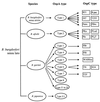Molecular typing of Borrelia burgdorferi sensu lato: taxonomic, epidemiological, and clinical implications
- PMID: 10515907
- PMCID: PMC88929
- DOI: 10.1128/CMR.12.4.633
Molecular typing of Borrelia burgdorferi sensu lato: taxonomic, epidemiological, and clinical implications
Abstract
Borrelia burgdorferi sensu lato, the spirochete that causes human Lyme borreliosis (LB), is a genetically and phenotypically divergent species. In the past several years, various molecular approaches have been developed and used to determine the phenotypic and genetic heterogeneity within the LB-related spirochetes and their potential association with distinct clinical syndromes. These methods include serotyping, multilocus enzyme electrophoresis, DNA-DNA reassociation analysis, rRNA gene restriction analysis (ribotyping), pulsed-field gel electrophoresis, plasmid fingerprinting, randomly amplified polymorphic DNA fingerprinting analysis, species-specific PCR and PCR-based restriction fragment length polymorphism (RFLP) analysis, and sequence analysis of 16S rRNA and other conserved genes. On the basis of DNA-DNA reassociation analysis, 10 different Borrelia species have been described within the B. burgdorferi sensu lato complex: B. burgdorferi sensu stricto, Borrelia garinii, Borrelia afzelii, Borrelia japonica, Borrelia andersonii, Borrelia valaisiana, Borrelia lusitaniae, Borrelia tanukii, Borrelia turdi, and Borrelia bissettii sp. nov. To date, only B. burgdorferi sensu stricto, B. garinii, and B. afzelii are well known to be responsible for causing human disease. Different Borrelia species have been associated with distinct clinical manifestations of LB. In addition, Borrelia species are differentially distributed worldwide and may be maintained through different transmission cycles in nature. In this paper, the molecular methods used for typing of B. burgdorferi sensu lato are reviewed. The current taxonomic status of B. burgdorferi sensu lato and its epidemiological and clinical implications, especiallly correlation between the variable clinical presentations and the infecting Borrelia species, are discussed in detail.
Figures




References
-
- Anderson J F. Epizootiology of Lyme borreliosis. Scand J Infect Dis Suppl. 1991;77:23–34. - PubMed
-
- Anthonissen F M, De Kesel M, Hoet P P, Bigaignon G H. Evidence for the involvement of different genospecies of Borrelia in the clinical outcome of Lyme disease in Belgium. Res Microbiol. 1994;145:327–331. - PubMed
Publication types
MeSH terms
Substances
LinkOut - more resources
Full Text Sources
Other Literature Sources
Miscellaneous

